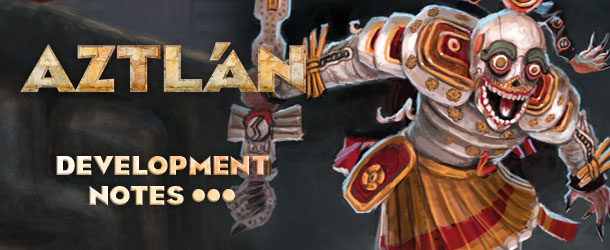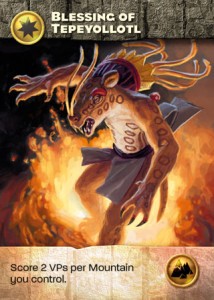Roberto Di Meglio, director of production of Ares Games, speaks about Aztlán, the new game by Leo Colovini that will be released at the Essen “Spiel 2012”. This third article is focused on the gameplay.
As befits a Colovini’s game, the rules of Aztlán are deceptively simple. The rulebook is 12 pages long, but that includes the cover, the explanation of components, a page of strategy tips, and a reference table that works as a calculator for calculating your victory points. Actual rules are about 6 pages long, including graphic examples!
The game can be played by 2 to 4 players: The game was originally designed as a 3-4 players game, then a 2-players version, “Aztec Gods” was added during development, more on this later.
Each player controls one of four different peoples, each identified by a totemic animal and a color: the blue Quetzal, the yellow Ocelot, the green Coyote and the red Serpent.
The game is played over 5 rounds, called “ages”.
Depending on the number of players, you start the 1st age by receiving a certain number of tribe pawns: 8 in a 3-players game, 7 in a 4-players game. In each of the following ages, you will receive one pawn less than in the previous one. As the game goes on, the board gets more crowded, and each pawn becomes more important, so the length of each round remains about the same in each of them.
You also receive a set of 6 “power cards”, numbered 4 to 9. Each card indicates the strength of your people in an age, and the terrain that will give you a victory point bonus in that age.
Starting with the player with more victory points (playing first is a disadvantage…), the players take one action in turn, until all pawns available for the current age are placed.
One action is very simple: place one pawn, anywhere on the board; then, if you want, move one pawn from one territory to an adjacent one.
When you place your pawns, you don’t have any restriction: you can place a pawn in a territory which already has an opponent’s pawns in it, for example, or far away from your other pieces. What you’re trying to achieve is to control a domain (an area of adjacent territories) as large as you can, including in it as many of your bonus terrains as possible. The bonus terrain is the one indicated by the power card you’ve chosen in that age – the more territories of that type in a single domain, the higher your scoring bonus.
As you’ve read in the previous post, each number on a power card is linked to a specific bonus terrain (so a ‘9’ card is related to cities, a ‘7’ to mountains, and so on). So when placing and moving, you will also try to bluff about your true goals, so that your opponents can not guess your strength in this age – or at the very least, they can guess only when it’s too late!
After each player has completed his or her actions, it’s showdown time! All players reveal their power card, and, again starting with the leading player, conflicts are resolved in all territories where more than one player is present. Each conflict is resolved in a very simple way: your power is the number of pawns multiplied by your current strength. The outcome is completely deterministic, there is no randomness, except the “fog of war” about the strength of your opponent. The only way to modify the outcome of a combat is by using certain prosperity cards, such as the “Great Tlatoani” or the “Eagle and Jaguar Warrriors”.
When you win a conflict, the fun part (at least for you!) begins… You can now decide whether the opponents you just defeated get to stay in the territory, and co-exist with you; or if you want, you can eliminate them. If you have more opponents, the same decision applies to all of them: you cannot decide to be merciful with one opponent and ruthless with another one.
If you decide to co-exist, your people will become more powerful: you receive a prosperity card for each territory where you win a conflict and decide to co-exist. Prosperity cards grant you different benefits, which in the end may prove to be game-winning. However, such a decision also brings consequences, as the opponent will maintain a presence in the territory, that will still count as a part of his domains, as well as yours. And of course, who can say what will happen in the next age, if they manage to get the upper hand, because their population or their strength become greater than yours?
After all conflicts are called out and resolved, it’s now time to look at your achievements. You will have one or more “domains”, each domain being a region with connected territories (if you’ve got the “Boats and Rafts” card, you can connect even through lakes, otherwise the territories must be adjacent). Each domain will give you a number of victory points which is related to its overall size and to the number of bonus territories included.
Initially, the scoring system gave you a number of victory points equal to the number of territories multiplied by the number of bonus territories. This very simple formula, however, produced a very high gap between low scores and high scores, which made the game sometimes subject to a classical “runaway leader” problem (that is, a player who takes the lead in the early game cannot be ever reached by the other players). We wanted to steer clear of this syndrome, of course, so together with Leo, during development we found a system which still gives a great importance to bonus terrains, but without the same problem.
The drawback of the new system is that the formula is slightly more complex, but for the less Math-inclined players, we included a reference card which tells you what the bonus is, and the rules include a more extensive table which gives you at a glance the value of a domain, taking into account both the overall size and the bonus territories in it. (If you’re curious, the new formula is “number of territories in a domain + square of the bonus terrains in that domain; if there are 0 bonus terrains, the domain has a value of 0”.)
Once the value of all the domains of each player is calculated, you can still add more victory points through the playing of prosperity cards (especially the various “Blessings of the Gods” cards).
Then, the points are added to your previous score, the victory points track is updated, and a new age begins. At the end of the 5th age, the final scoring will be the same, but you will also add up points for your unused prosperity cards, and especially for the “Offer to the Gods” cards that you accumulated during the game.
If everything seems to be too simple… well, that’s the beauty of Aztlán! As it’s the mark of “classic” great strategy games, the rules are very simple, but the strategy is deep, and requires many games to be explored in depth. In the next posts, we’ll give some strategy tips (also included in the rules), and talks about the 2-players variant which was designed during the development of the game.
The rules of Aztlán are already online. Click here to see and download the rulebook.














Follow Us on